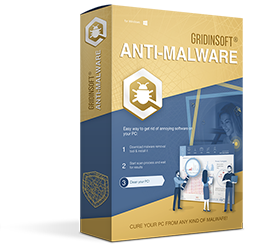Recently, Bittradein.com service appeared, promoting itself as a platform to keep cryptocurrency and other assets safely. I managed to gather credible evidence that clearly reveals it is, in fact, a fraudulent service.
Despite the promises of the most user-friendly, dependable, and client-friendly service, Bittradein.com does not fulfill any of them. In fact, all this is just a gilded wrap around a clear scam, which steals your funds and never returns them. Any tales about gifts, endorsement from celebrities etc are nowhere to be found as well.
Bittradein Scam Overview
Originally, Bittradein poses as a cryptocurrency trading & cryptowallet platform with exceptionally low commission fees. Another highlighted marketing point for this service is partnerships with celebrities that are known as crypto activists. Vitalii Buterin (Ethereum creator), Elon Musk, Jeff Bezos, Bill Gates, Warren Buffet – the site claims having significant support from them. To make these claims look real, rascals use AI-generated videos with those celebs promote the fraud as if it was the best thing in the world. Obviously, Elon Musk is the most common among them. But, as I said in the introduction, all this is just a vivid wrap around an obvious scam.
First and foremost, Bittradein copies the design of multiple similar online platforms. There are quite a few examples, like Dyig, Torwaxe or Cenutix. They are completely undistinguishable in terms of graphic elements, with small discrepancies in the website header. Other specific elements, and sometimes even crypto wallet addresses, are unchanged. Probably, all these fraudulent sites are led by the same group of swindrels.
Cryptocurrency Scam Summary
| Website | Bittradein.com |
| Hosting | AS47583 Hostinger International Limited France, Paris |
| IP Address | 147.79.103.80 |
| Threat Type | Scam/Fraud |
| Scam Type | Fraudulent offers of cryptocurrency services |
How the Bittradein Scam Works?
Bittradein is a part of a extensive cryptocurrency scam scheme that started circulating vividly in 2023. Scammers who stand behind it use various website designs, which still share the similar overall layout. Another mutual element are the ways the scams like NAME are promoted, and the manner all this ends up to the victim of the scam. To reach peak efficiency, frauds apply advanced psychological tricks that make the user believe in the legitimacy of the website. But let’s review them one by one.
Step 1: Promotion
To initiate the fraud, criminals set up and fill accounts on well-liked social media platforms. They mainly aim at Facebook, Instagram, Twitter, and TikTok. Subsequently, the advertising campaign begins. Utilizing bots and paid promotions (when possible), fraud actors intensify the presence of their scam activities to possible victims. And as I said, fraudsters do not shy away using generative AI for creating clips with the aforementioned celebrities that promote their scam to the public. To boost the folks even more, frauds claim the bonus for every user who enrolls the service immediately.

Promotions of cryptoscams like Bittradein in TikTok. Most of these videos are AI-generated deepfakes
Users get an encouragement to enroll, enticed by the commitment of obtaining cryptocurrency prizes valued at hundreds of dollars, all free of charge. To increase the attractiveness of the offer, fake suggestions of cooperation with a celebrity are added. As you may guess, these claims are entirely baseless.
Step 2: Gaining Traffic
After clicking the promotions, targets end up on a page filled with attractive offers. “Crypto starts with Bittradein”, “Your crypto savings are secured with Bittradein, “Start earning with Bittradein – they look rather credible. To heat up the interest and make the users proceed to step 3, fraudsters say that unlocking the pledged bonus requires registration. And as nothing questionable happens at this point, uninformed users happily proceed – especially since the reward appears to be right behind the corner.
This is the last stage when it is possible to get away from the scam without any losses. Before you register using your personal data, crooks will not be able to earn even a penny from your presence on the website.
Step 3: Data Gathering
This is the starting poing of the main fraud action. As I just mentioned, scammers bait folks into signing up to get bonuses. And all the personal information needed for it – email, username, crypto wallet address – are valuable for user identification. Only by gathering this data and selling it further into the Darknet, swindlers can earn quite a penny. Still, their plans go much further.
As it turns out, you cannot use the promised bonus right away. To make it at least usable for crypto purchases, you need to top up the account with the sum of a bonus. At this point, the final stage of the scam kicks in.
Step 4: Requesting funds
It is obvious that any crypto operations require you to have money on your account. With Bittradein, users are also forced to top up to use the bonuses. And this is what creates the majority of the money flow to this scam site. By topping up the account, users hope to get the committed gift (usually $500-1000 in USDT), and may start engaging on this site hoping to use all the credited funds and withdraw them.
This, however, is where the first obvious issues start to surface. When comparing the real crypto wallet vs what the website says, you can observe that no transactions are done whatsoever. And then, when you’d try to retrieve the funds from your account, the scam is finally uncovered to the user.
Step 5: Escaping from Funds Withdrawal
Needless to say that swindlers are naught on intentions to give your money back. But to make the denial look more realistic, they’ve crafted a whole pack of reasons to decline the withdrawal request. Usually, they repeat what Know Your Client requirements say, but for the Bittradein.com they are here only to make the wireout impossible.
By requesting your personal information, scammers just stall hoping for you to understand that you’ve been scammed and stop contacting them. If you don’t – well, there are numerous other checks you would desperately need to undergo before getting your funds back. And every check will uncover more and more info of yours, which – you guessed it right – will be then traded on the Darknet. Never reveal your real info to strangers!
Signs of Scam
I gathered several facts that point at the scammy nature of the Bittradein.com. Actually, there are a lot of scams that fall under the same points, so they are pretty much universal.
- False Celebrity Sponsorship. Bittradein often resorts to fake endorsements from celebrities such as Elon Musk, Jeff Bezos, Mr. Beast, and Mark Zuckerberg. This fraudulent tactic extends to claiming partnerships with reputable companies like Coinbase, Binance, or MetaMask, despite lacking any genuine affiliations.
- Cryptocurrency-Only Payments. Bittradein.com exclusively accepts payments in cryptocurrencies, rejecting traditional bank transfers and other methods. This approach not only masks the company’s identity but also eliminates the possibility of seeking refunds.
- Dubious Company Information. Bittradein raises suspicion by withholding essential ownership, location, and registration details. Furthermore, the absence of legitimate contact information and the recent establishment of domain and social media pages intensify skepticism.
- Unsubstantiated Hype. Bittradein.com employs groundless hype tactics, fabricating events like securing contracts with Coinbase or receiving endorsements from Elon Musk. These manipulative techniques aim to instill false confidence and encourage further investments.
- Potential Pyramid Scheme. The scam relies on a structure resembling a Ponzi scheme, leveraging a referral system spread through social media. However, only initial participants benefit, often at the expense of subsequent investors.
- Implausible Claims. Promising returns of 50-100-200%, Bittradein preys on the desire for quick profits. Yet, the volatile nature of the cryptocurrency market makes such gains highly unlikely, definitively labeling Bittradein as a scam.
What Should I do as a Victim?
If you had to deal with Bittradein site and fell victim to that scam, there are still some steps to take. They will make further scam attempts harder, and also boost the knowledge about that scam among folks.
- Secure Your Actions. Begin by promptly reporting the scam to appropriate local authorities tasked with handling financial fraud. Notify wallet providers and engage with social networks’ technical support teams. By taking these measures, you contribute to making the scammers’ operations significantly more difficult.
- Expand Awareness. Extend your efforts by sharing the scam information with your close friends. This action has a parallel effect to reporting to the authorities, as disseminating details about fraudulent crypto services reduces the potential victims they can deceive.
- Gather Evidence. Preserve comprehensive evidence by capturing screenshots and saving all pertinent data linked to the deceptive website. Collect the URL, screenshots of the main page, login interface, end-user license agreement (EULA), account top-up menu, and wallet addresses. These materials could prove invaluable for authorities in their pursuit of the scammers.
- Explore Refund Possibilities. While cryptocurrency payments generally fall outside the scope of refund policies within most banks, it’s worth investigating the potential for a refund in specific circumstances. Maintain optimism until you definitively confirm the loss.
- Convert Mistake into Wisdom. Transform your financial setback into a valuable learning experience. Treat your loss as an investment in understanding the tactics of crypto scam sites. Familiarize yourself with their key characteristics, how they lure individuals, and the grandiose promises they make. Armed with this knowledge, you’ll be well-equipped to recognize and avoid falling into future traps without incurring further losses.
Scan your system for possible malware infections
Beware of cross scams! Scam actors can use your trust to make you download some stuff or interact with certain documents. It may be a trap that installs malware to your system. There are no moral barriers or limits for these scoundrels.
Throughout the course of the fraud, its actors may contact you with specific files. Alternatively, they may offer you to set up “cryptocurrency wallet applications” or “browser extensions” to streamline access to your cryptocurrency savings. As we earlier figured out, these scoundrels have no plan of restoring your funds. So, what do these messages and browser extensions represent? Correct – that is another element of the deceptive plan designed to throw you into deliberately running malicious applications onto your computer.
Both add-ons and files attached to emails can serve as a carrier for different malicious code. In this situation, I anticipate the presence of spyware and stealers among other forms of malware. While it is not mandatory for scammers to distribute malware, the chance is always above zero. As noted, their ethics is of no concern, and their dignity is already severely tarnished. They have no scruples to give up and aim to boost revenues.
Remove spyware with Gridinsoft Anti-Malware
We have also been using this software on our systems ever since, and it has always been successful in detecting viruses. It has blocked the most common malicious programs as shown from our tests with the software, and we assure you that it can remove spyware as well as other malware hiding on your computer.
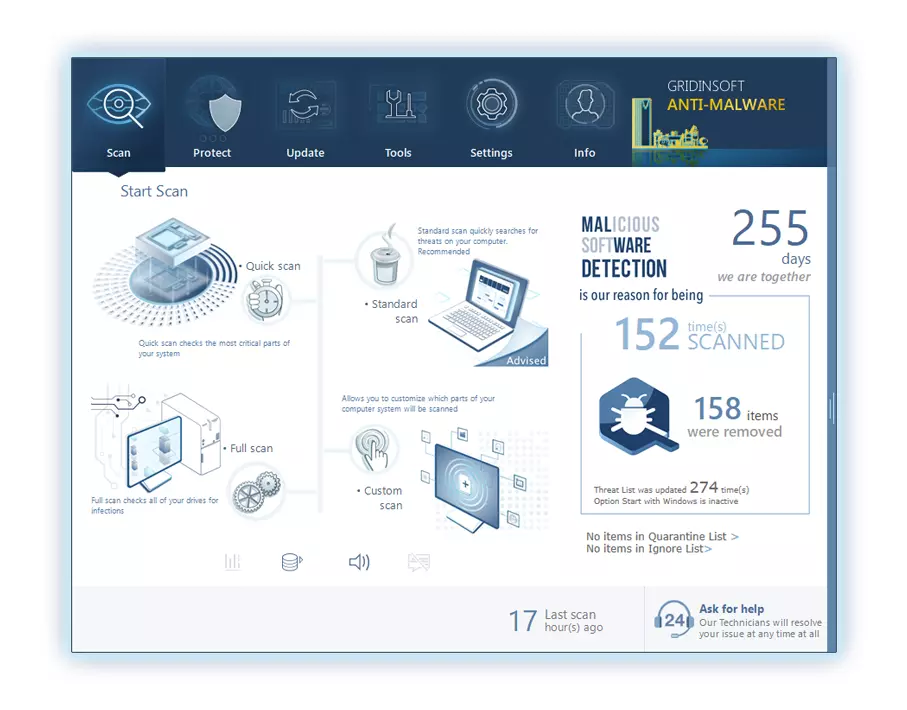
To use Gridinsoft for remove malicious threats, follow the steps below:
1. Begin by downloading Gridinsoft Anti-Malware, accessible via the blue button below or directly from the official website gridinsoft.com.
2.Once the Gridinsoft setup file (setup-gridinsoft-fix.exe) is downloaded, execute it by clicking on the file.
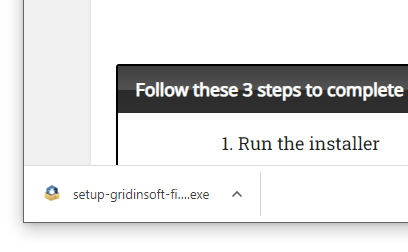
3.Follow the installation setup wizard's instructions diligently.
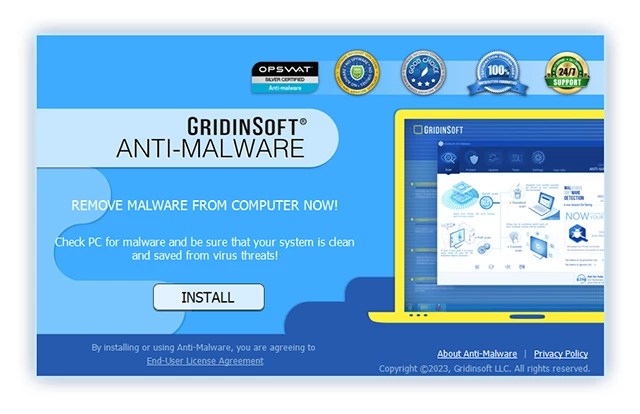
4. Access the "Scan Tab" on the application's start screen and launch a comprehensive "Full Scan" to examine your entire computer. This inclusive scan encompasses the memory, startup items, the registry, services, drivers, and all files, ensuring that it detects malware hidden in all possible locations.
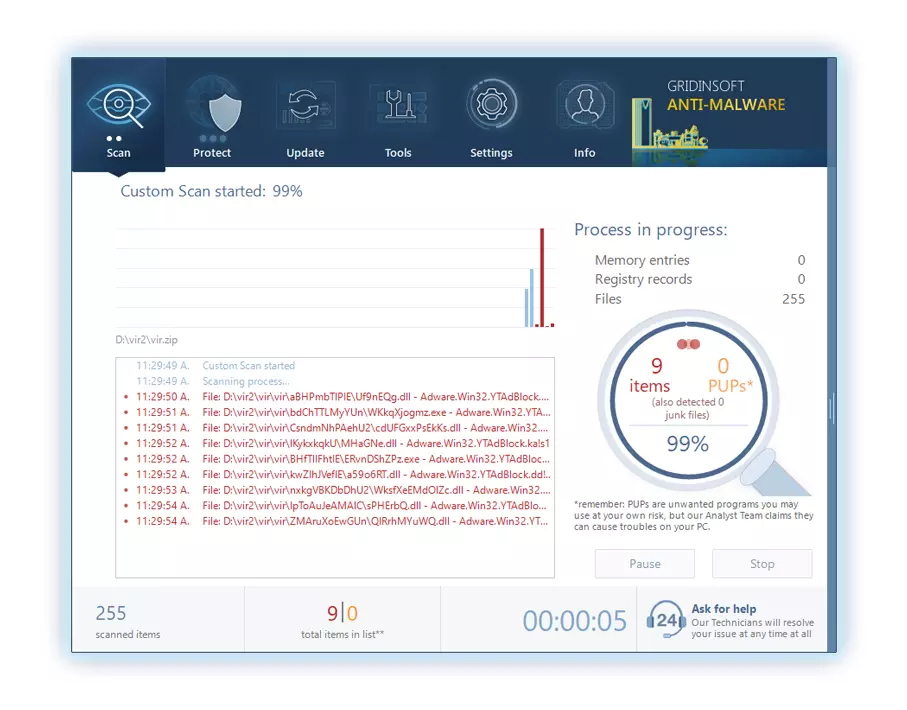
Be patient, as the scan duration depends on the number of files and your computer's hardware capabilities. Use this time to relax or attend to other tasks.
5. Upon completion, Anti-Malware will present a detailed report containing all the detected malicious items and threats on your PC.

6. Select all the identified items from the report and confidently click the "Clean Now" button. This action will safely remove the malicious files from your computer, transferring them to the secure quarantine zone of the anti-malware program to prevent any further harmful actions.
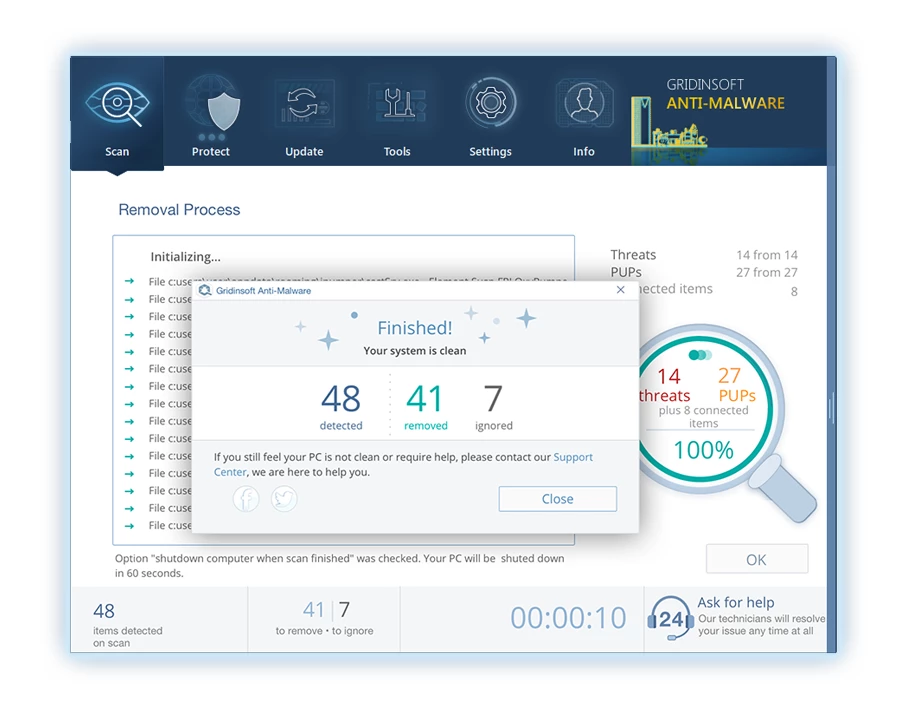
8. If prompted, restart your computer to finalize the full system scan procedure. This step is crucial to ensure thorough removal of any remaining threats. After the restart, Gridinsoft Anti-Malware will open and display a message confirming the completion of the scan.
Remember Gridinsoft offers a 6-day free trial. This means you can take advantage of the trial period at no cost to experience the full benefits of the software and prevent any future malware infections on your system. Embrace this opportunity to fortify your computer's security without any financial commitment.
Frequently asked questions
The vast majority of information posted on the Bittradein site is false. It is either fabricated, or a manipulation that misses the context of mentioned events. However, things like quotes or other interactive elements related to current prices may be trustworthy. But I would rather avoid using them as a primary source of information.
No, there is no legitimate information on the Bittradein site. The operators of this site use fabricated details and deceptive tactics to create an appearance of credibility, such as appealing visuals and claims of being a licensed company. However, these claims are false, and the site is part of a larger network of interconnected crypto scam sites designed to defraud victims. The scammers manipulate users into providing sensitive personal information and making deposits, ultimately leading to the loss of funds.
Unfortunately, recovering funds lost to a scam like Bittradein can be extremely challenging, if not impossible. Scammers often operate from obscure locations and use various tactics to cover their tracks, making it difficult to trace or retrieve the stolen funds. In many cases, these scams are designed to exploit victims and disappear once they have obtained the money.
Spotting crypto trading scams requires vigilance and a critical eye. Here are some tips to help you identify potential crypto trading scams in the future:
- Question Unrealistic Promises. Approach offers that promise unrealistically high returns or guaranteed profits with caution. If an investment opportunity sounds too good to be true, it probably is.
- Scrutinize Celebrity Endorsements. Exercise skepticism when encountering endorsements from celebrities or public figures. Scammers often create fabricated endorsements to enhance their credibility.
- Verify Regulation and Licensing. Investigate whether the platform or service holds proper regulation and licenses from relevant authorities. Scammers frequently operate without legitimate authorization.
- Consult Reviews and Feedback. Seek out independent reviews and feedback from other traders. Positive reviews can be falsified, but negative reviews may offer valuable insights.
- Resist Urgency. Be wary of tactics that use a false sense of urgency to rush your decisions. Legitimate investments provide the necessary time for thorough research and contemplation.
If you have become a victim of a Bittradein or similar crypto trading scam, it’s important to take immediate action to minimize further damage and increase the chances of recovering your losses. Here’s what you should do:
- Cease Communication. If you realize that you’ve been scammed, stop all communication with the scammers. Do not respond to their emails, messages, or calls.
- Document Everything. Gather and preserve all relevant information, including emails, screenshots, transaction records, and any communication you had with the scammers. This documentation will be crucial for reporting the scam and seeking assistance.
- Report to Authorities. File a report with your local law enforcement agency and any relevant regulatory authorities in your country. Provide them with all the evidence you have gathered. This helps initiate investigations and raises awareness about the scam.
- Contact Financial Institutions. If you made any payments or deposits using your credit card or bank account, contact your financial institution immediately. They may be able to help you with disputing transactions or initiating a chargeback.
- Seek Legal Advice. Consult with a legal professional who specializes in fraud or financial matters. They can provide advice on potential legal actions you can take to recover your funds.
- Notify Cryptocurrency Exchanges. If you used a cryptocurrency exchange to make transactions related to the scam, notify the exchange about the fraudulent activity. They may be able to assist you in some cases.
- Monitor Your Accounts. Keep a close eye on your financial and online accounts for any suspicious activity. Change passwords and enable two-factor authentication wherever possible.

